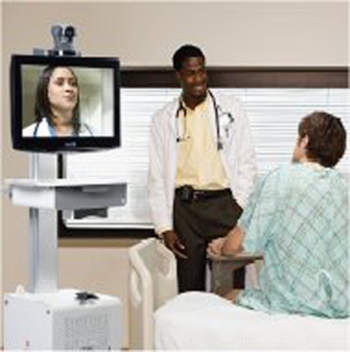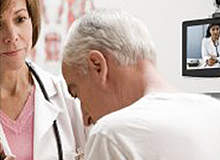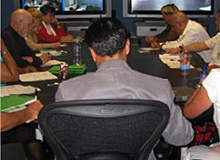A not-for-profit organization, the Seton Family of Hospitals is the leading provider of healthcare services in Central Texas, serving an eleven-county population of 1.8 million. The organization operates five major medical centers, two community hospitals, two rural hospitals, an inpatient mental health hospital, several strategically located health facilities that provide rehabilitation and medical care for well patients, and three primary care clinics for the uninsured.
As the region’s largest community service organization, Seton contributed more than $282m to care for the poor and community benefit last year. The Seton philosophy is to provide healthcare that works, healthcare that is safe, and healthcare that leaves no one behind. That can be a tall order, however, in an area as large and geographically dispersed as Central Texas, which is why Seton looked to Polycom for a full-featured, high-quality video telemedicine solution.
“We have a responsibility to reach out to the communities we serve and get patients in front of physicians, even if those patients are located in very remote regions,” explains Brian Henry, telemedicine program developer at Dell Children’s Medical Center of Central Texas, the central hub of Seton’s telemedicine program. “For example, Dell Children’s Medical Center supports a 46-county area surrounding Austin that is almost the size of the entire state of Ohio. At the outset, we knew that a telemedicine program would have to be developed in order to properly serve these communities.”
Seton launched telemedicine programs at its Dell Children’s Medical Center of Central Texas and the Seton Brain & Spine Institute, making it the first healthcare organization in the state to offer a pediatric trauma telemedicine program and the first in central Texas to use the technology for stroke assessment and treatment.
Expertise on demand
Seton deployed the Polycom® Practitioner Cart® HDX® mobile healthcare solution to bring wireless high definition video, voice, and image sharing to its medical professionals and patients. The telemedicine network covers five Seton facilities including University Medical Center Brackenridge, Dell Children’s Medical Center of Central Texas, Seton Highland Lakes, Seton Hays County, and Seton Medical Center Williamson.
“When I was brought into the telemedicine project, Seton was already heavily engaged with Polycom, so I sort of inherited Polycom as a vendor,” says Henry. “That said, I have been extremely satisfied in terms of service and attention to detail from the engineering side. A lot of thought and design work has to go into an implementation of this scope and Polycom has been there to help us understand that and build a telemedicine network that will scale as we move forward.”
The telemedicine program based at Dell Children’s Medical Center of Central Texas will provide access over video to immediate, expert pediatric trauma resources to a 46-county region. As one of only 17 level one pediatric trauma centers in the country and the only dedicated children’s hospital in Central Texas, the importance of dispersing Dell Children’s expertise as widely as possible cannot be overstated.
The Seton Brain & Spine Institute telemedicine program connects neurologists with remotely located patients for the evaluation of stroke severity and treatment recommendations. The ability for experts to immediately examine stroke patients is critical to determining those who could benefit from life-saving therapies that must be administered within a small window of time.
Reaching out to the community
Henry and his colleagues worked very closely on the development of the telemedicine program with the hospital clinicians who will be using the systems and expect that will speed adoption and use. In this first year of the program, Henry anticipates telemedicine will replace or assist in the 20 to 30 pediatric trauma cases that are transferred to Dell Children’s Medical Center each month and the up to 13,000 neurology consultations that occur each year.
“Central Texas is a huge land mass, where hospitals are very far away from each other,” explains Henry. “Telemedicine is allowing us to link them together now and get patients in front of specialists sooner rather than later. We’re dealing with situations where minutes count and using video telemedicine is simply the best way to improve care delivery. It’s such a rich media, a telephone call just doesn’t compare.”
In a typical pediatric trauma case, if an injury is severe enough, the patient will be transported to Dell Children’s Medical Center. But in the first critical few minutes, telemedicine enables a pediatric trauma expert to provide guidance on immediate care, such as whether or not to intubate or the right size and placement of tubes, all things that ultimately improve a child’s chance of survival. This early intervention also gives the Dell Children’s Medical Center team a better idea of the type of trauma they will be receiving.
“By reaching out to the many regions in Central Texas that have limited experience with critical pediatric illness or injury, we’re going to be able to improve survival rates among children,” says Henry.
Henry reports positive physician reaction to the telemedicine solution. “It’s all thumbs up so far,” he says.
Expanding access
With the first phase of the telemedicine rollout completed and the second – linking to emergency departments and clinics outside of the Seton network – underway, the Seton Family of Hospitals is looking toward expansion.
“Telemedicine really does improve the patient/physician relationship,” says Henry. “Now that we’ve proven that, all the other specialties want to participate.”
In addition, there is excitement throughout the health system to capture stimulus funding to link the organization’s 22 community clinics over video.








